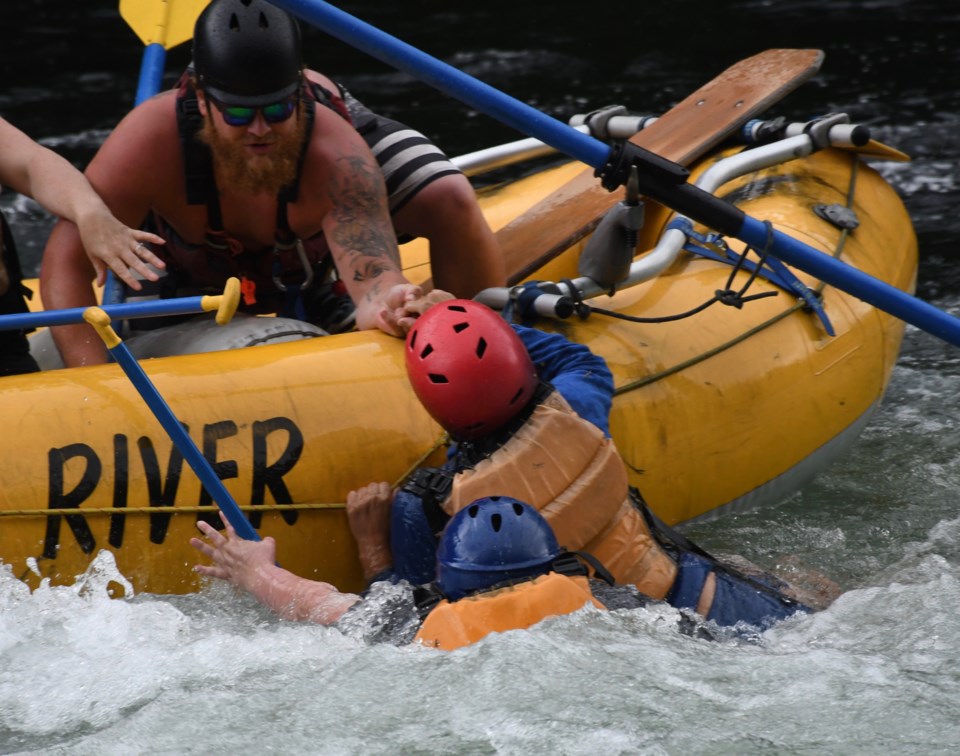It was a very simple rule.
During one of my first trips down the Thompson River as a misbehaving youth group kid, our deeply tanned British guide reminded me repeatedly that I wasn’t allowed to swing my leg to the outside of the raft like I was straddling a horse. Instead, both feet were supposed to be anchored inside while I used that leverage to paddle. I didn’t like this particular posture, preferring to manspread, and sneakily draped my leg off the raft whenever I thought she wasn’t looking.
I believe the Class 3 rapid we hit was called The Witch’s Cauldron. It might’ve been the Cutting Board. Either way, we were in the thick of watery chaos when a wave took ahold of my leg and casually wrenched me off the side of the raft. It was my first experience of sublime panic, the white cold rush you get when you’re convinced you’re about to die. The angry waves surrounding me seemed mountainous, and a gurgling whirlpool swirled nearby. Lucky for me, the guide successfully hit me in the face with the rescue throw bag and quickly pulled me to safety, hand over hand.
I still remember the look of panting incredulity on her face as she got back on the oars, paddling us through the remainder of the rapid.
“What did I tell you about putting your leg over the side?” she asked.
I didn’t have a good answer.
As whitewater rafting season in Squamish kicks into full swing, and Sea to Sky residents venture out on all our beautiful surrounding waterways, I thought I would take this opportunity to offer 6 simple tips to keep in mind while paddling this summer.
#1. Never let go of your T-grip
We call it a T-grip because it ends up in people’s teeth.
Believe it or not, the butt end of your paddle is the most dangerous part of any rafting trip. If you let go of it, it has a tendency to flail around injuring people. That’s why we remind guests to keep it firmly squeezed in one hand for the entire trip down the river. If you mess this up, the guide will shout “T-grip!” over and over until you comply, just to embarrass you.
#2. Paddle with your body, not your arms
It’s just the smarter way to do it.
There are a lot of athletically inclined people that feel they can soldier through on their arm strength alone, but they’ll pretty quickly realize that the people who are using their core aren’t as tired, and seem to be coasting along having more fun. That’s because if you lean forward, dip your paddle, then pull back with your body weight instead of your arms, it takes 90% of the pressure off your throbbing biceps and puts it on to your much stronger legs and core.
#3. Make sure your helmet and lifejacket fit properly
If you don’t follow this rule, you may end up getting laughed at.
Maybe it’s mean, but seeing someone try to swim with a baggy lifejacket that rides up over their head while they squawk annoyed is pretty darn funny. The thing is, every life jacket can fit you if you tighten the straps properly. Most companies have life jackets that are one size fits all, so the only thing you need to do to avoid mishaps on the river is ensure your straps are pulled as tight to your ribcage as possible.
Same goes with the helmet, which can fall over your eyes or flop around uncomfortably. Make sure you’re comfortable with the fit before you step on the raft.
#4. If you fall in, breathe between the waves
This is actually counterintuitive.
When you experience swimming through rapids, you’ll find that your instinct is to breathe at the apex of the wave, when you’re the furthest away from being underwater. But because the top of the wave breaks with spray, often you’ll end up drinking that breath. Instead wait until the calm lull between waves, quickly sip air through your mouth, then close it for the crash of the next wave.
#5. Practice fear management
Nearly everybody on your trip will be afraid at some point. That’s part of the plan.
The amazing thing about whitewater rafting is it allows you to practice fear management, to feel that rush of adrenaline and panic and then decide to do what’s expected of you anyway — paddle. It’s when you cower or shrink from the challenge that you’re more likely to fall off the side, but if you paddle like a maniac, your fear will become irrelevant quite quickly.
#6. Practice pulling yourself and others into raft pre-trip
Not everyone can pull themselves into the raft, and that’s okay.
Before you take off down the river, each person should try going down in the water and then trying to pull themselves back in. If they can’t do it, practice having the others grab them by the lifejacket lapels and drag them up in a big watery heap. This process can often be hilarious, but it prepares you for that moment downriver when someone ends up in the current.
It’s probably because they weren’t listening to the rules.
Will Johnson is a freelance contributor to The 小蓝视频 and a whitewater rafting guide.


